Solar eclipse of October 24, 1995
| Solar eclipse of October 24, 1995 | |
|---|---|
|
| |
 Map | |
| Type of eclipse | |
| Nature | Total |
| Gamma | 0.3518 |
| Magnitude | 1.0213 |
| Maximum eclipse | |
| Duration | 130 sec (2 m 10 s) |
| Coordinates | 8°24′N 113°12′E / 8.4°N 113.2°E |
| Max. width of band | 78 km (48 mi) |
| Times (UTC) | |
| Greatest eclipse | 4:33:30 |
| References | |
| Saros | 143 (22 of 72) |
| Catalog # (SE5000) | 9498 |
A total solar eclipse occurred on October 24, 1995. A solar eclipse occurs when the Moon passes between Earth and the Sun, thereby totally or partly obscuring the image of the Sun for a viewer on Earth. A total solar eclipse occurs when the Moon's apparent diameter is larger than the Sun's, blocking all direct sunlight, turning day into darkness. Totality occurs in a narrow path across Earth's surface, with the partial solar eclipse visible over a surrounding region thousands of kilometres wide. The path of totality went through the Middle East, Asia, Indonesia.
Images

Related eclipses
Solar eclipses 1993-1996
Each member in a semester series of solar eclipses repeats approximately every 177 days and 4 hours (a semester) at alternating nodes of the Moon's orbit.
| Descending node | Ascending node | |||
|---|---|---|---|---|
| Saros | Map | Saros | Map | |
| 118 | May 21, 1993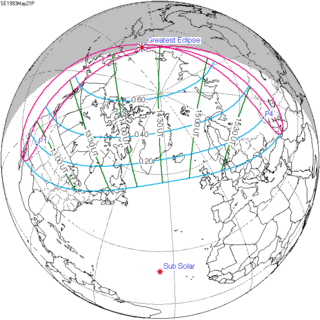 Partial |
123 | November 13, 1993 Partial | |
| 128 | May 10, 1994 Annular |
133 | November 3, 1994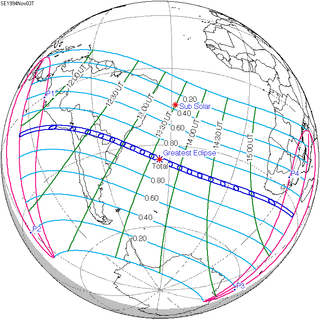 Total | |
| 138 | April 29, 1995 Annular |
143 Totality at Dundlod, India | October 24, 1995 Total | |
| 148 | April 17, 1996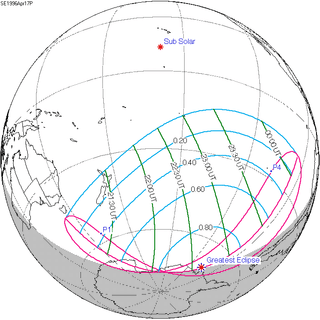 Partial |
153 | October 12, 1996 Partial | |
Solar 143
It is a part of Saros cycle 143, repeating every 18 years, 11 days, containing 72 events. The series started with partial solar eclipse on March 7, 1617 and total event from June 24, 1797 through October 24, 1995. It has hybrid eclipses from November 3, 2013 through December 6, 2067, and annular eclipses from December 16, 2085 through September 16, 2536. The series ends at member 72 as a partial eclipse on April 23, 2873. The longest duration of totality was 3 minutes, 50 seconds on August 19, 1887.[1]
| Series members 17–28 occur between 1901 and 2100 | ||
|---|---|---|
| 17 | 18 | 19 |
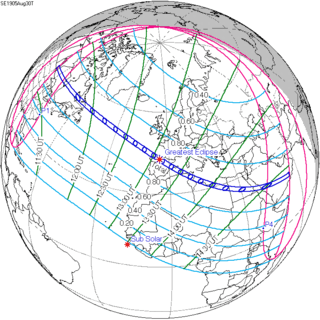 August 30, 1905 |
 September 10, 1923 |
 September 21, 1941 |
| 20 | 21 | 22 |
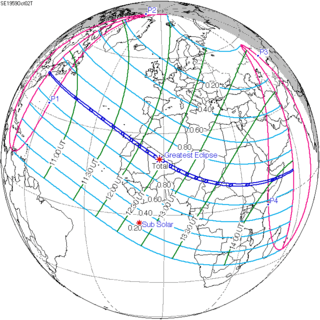 October 2, 1959 |
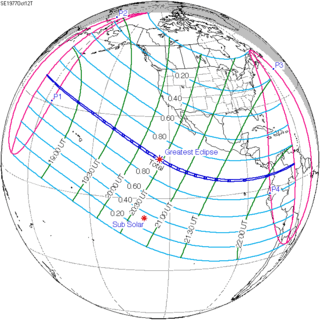 October 12, 1977 |
 October 24, 1995 |
| 23 | 24 | 25 |
 November 3, 2013 |
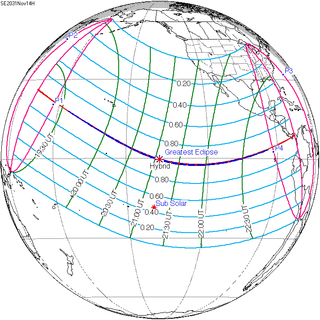 November 14, 2031 |
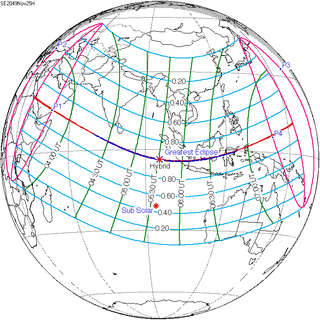 November 25, 2049 |
| 26 | 27 | 28 |
 December 6, 2067 |
 December 16, 2085 | |
Metonic series
The metonic series repeats eclipses every 19 years (6939.69 days), lasting about 5 cycles. Eclipses occur in nearly the same calendar date. In addition the octon subseries repeats 1/5 of that or every 3.8 years (1387.94 days).
| 21 eclipse events between August 12, 1942 and August 11, 2018 | ||||
|---|---|---|---|---|
| August 10-12 | May 30 | March 18 | January 4-5 | October 23-24 |
| 115 | 117 | 119 | 121 | 123 |
 August 12, 1942 |
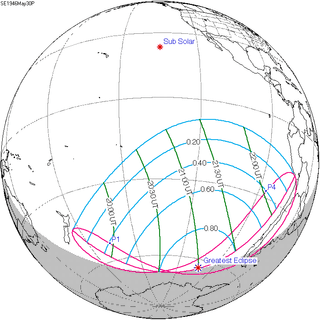 May 30, 1946 |
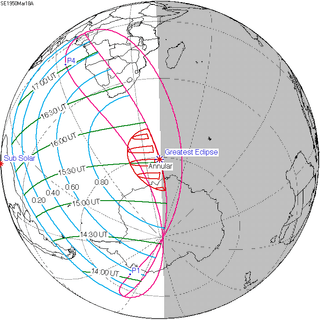 March 18, 1950 |
 January 5, 1954 |
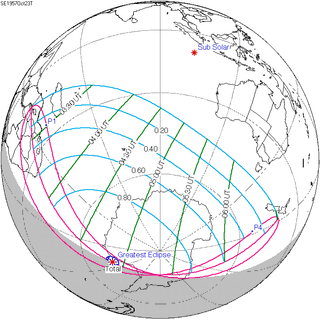 October 23, 1957 |
| 125 | 127 | 129 | 131 | 133 |
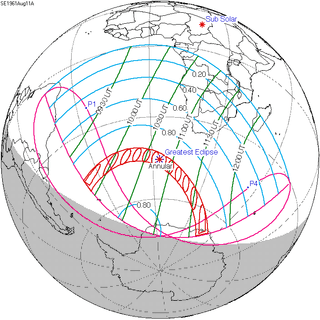 August 11, 1961 |
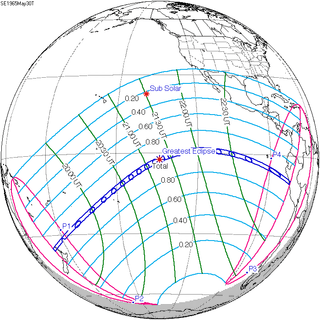 May 30, 1965 |
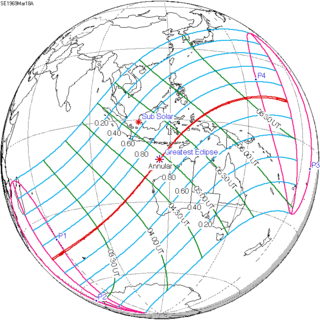 March 18, 1969 |
 January 4, 1973 |
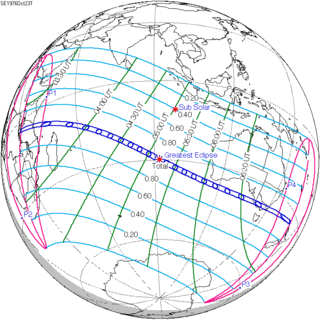 October 23, 1976 |
| 135 | 137 | 139 | 141 | 143 |
 August 10, 1980 |
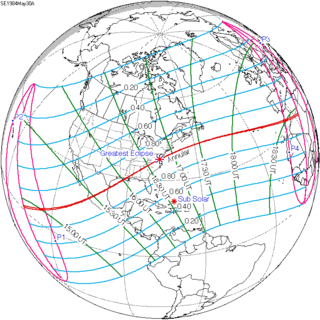 May 30, 1984 |
 March 18, 1988 |
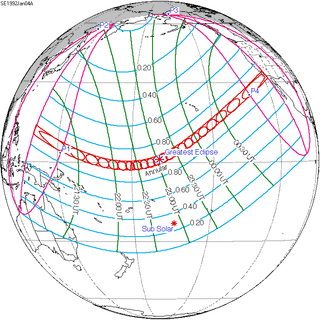 January 4, 1992 |
 October 24, 1995 |
| 145 | 147 | 149 | 151 | 153 |
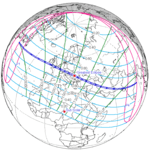 August 11, 1999 |
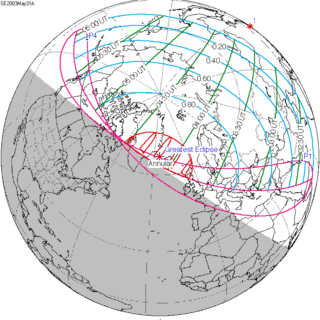 May 31, 2003 |
 March 19, 2007 |
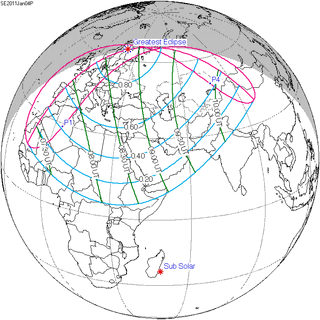 January 4, 2011 |
 October 23, 2014 |
| 155 | ||||
 August 11, 2018 | ||||
In popular culture
Phil Whitaker's prize-winning debut novel Eclipse of the Sun published in 1997 and set in India has at its centre a dramatic attempt to organize a public viewing of the eclipse.
Notes
References
- Earth visibility chart and eclipse statistics Eclipse Predictions by Fred Espenak, NASA/GSFC
Photos:
- Prof. Druckmüller's eclipse photography site
- Rušin from Nim Ka Thana, India
- Russian scientist had no successful observation of the eclipse
- Russian scientist had no successful observation of the eclipse (2)
- The 1995 Eclipse in India
| Wikimedia Commons has media related to Solar eclipse of 1995 October 24. |
